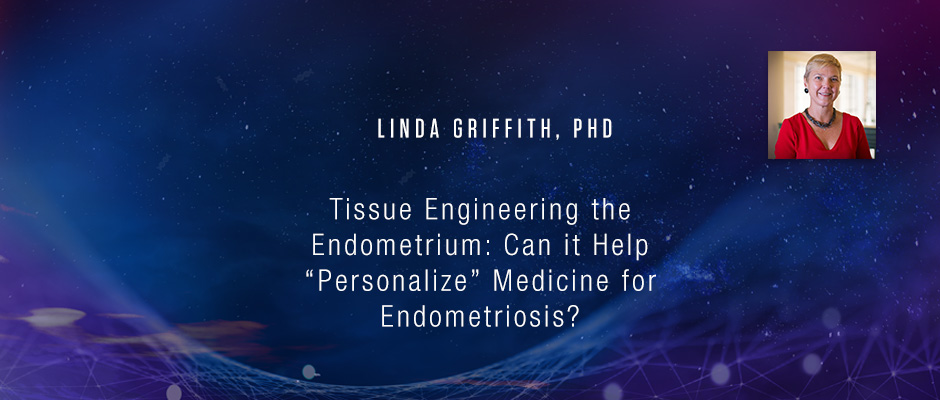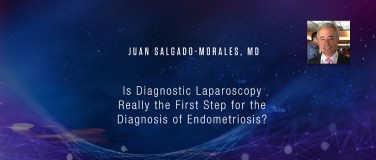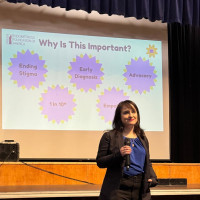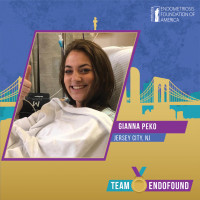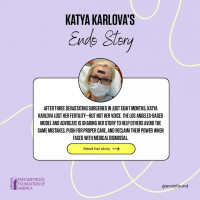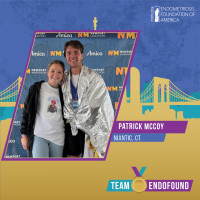Linda Griffith, PhD - Tissue Engineering the Endometrium: Can it Help “Personalize” Medicine for Endometriosis?
Endometriosis Foundation of America
Medical Conference 2019
Targeting Inflammation:
From Biomarkers to Precision Surgery
March 8-9, 2019 - Lenox Hill Hospital, NYC
https://www.endofound.org/medicalconference/2019
Okay, so I've added a little subtitle on the top, which is, "Move over, Mice!" That's move over, not get out of the way because I think that there's a role for animal models but I also feel that there's an increasing role to have more complex models of the human condition. So my lab's a tissue engineering lab and I worked in regenerative medicine for a long time and then started turning more toward these kinds of models, mainly for liver and the GI tract and others. Only a small part of my lab, but the most important part of my lab, work on reproductive health. Everything in my lab, though, everyone is involved in endometriosis because, as you heard from Hugh Taylor, it is a systemic disease. So we think about that a lot.
So what I'd like to do, I started working on endometriosis about 10 years ago, pulled in by my wonderful clinical collaborator, Keith Isaacson, who said there's really no great therapies for these patients. My niece in Atlanta had just recently gotten diagnosed. Fortuitously, right after we started working together, I got diagnosed with breast cancer. I was immediately classified as triple negative, which is not a super good thing, but it was just one year of horrible stuff and then it was done. Endometriosis is a lifelong horrible thing for many women. What it made me realize is we don't have great ways to molecularly classify endometriosis patients. Endometriosis is not one disease. We've heard that today and we hear that everywhere, and so a lot of what we're trying to do in our overall program and community is thinking about ways that we could classify patients.
I put in a slide on adenomyosis. I haven't heard it mentioned much today, and you'll see in the upper right-hand corner of this slide a calibration for how little adenomyosis is studied. I compare PubMed citations of adenomyosis. Adenomyosis is when you have endometrial glands and stroma misplaced in the myometrium, arguably hugely under-diagnosed. Katerina [inaudible 00:02:11] published some beautiful work showing how you could infer it from imaging studies, and now it's more commonly suspected but we're really only the tip of the iceberg on this. But you can see that a disease everyone would presume is cured because you watch football, you see ads for drugs for ... Erectile dysfunction has almost 24,000 papers and adenomyosis only 2,300. So we have a long way to go, and I hope in future years we have this at the disease.
We started out with a hypothesis, and I know there's a woman here who says she's completely asymptomatic and infertility was the first way she presented. This underscores how patients can present very differently, not just endometriosis but almost all chronic inflammatory diseases, arthritis, etc. So are there molecular mechanisms that differentiate groups of patients from each other? One way we might learn about this is from the kind of studies Stacey Missmer does in GWAS. That's from the genes up. A way we also approach it is from the top down, thinking about networks of inflammation, invasion, etc., that may be diagnostic of different subsets of endometriosis. I put hypotheses. We haven't proven this, but it is something I think work considering. It requires large patient populations.
Okay, so first of all, how do we even find mechanisms in groups? I'm not going to focus on that today; I'll just mention what we've done. But these studies on patient populations led us to think if we find mechanisms and we want to develop drugs for subsets of patients, personalized medicines, how do we tell that they're effective? Every drug company I have talked to about new classes of drugs for endometriosis outside of hormones, you've got to have an efficacy model. That's what they say over and over and over. And it has to be something other than animal models because we have cured so many animals of endometriosis with new classes of drugs. That's what I really want to talk about today, the tissue engineering models.
Now, I will mention that the motivation for what I'm going to talk about is a whole set of studies we've done in patients with collaborators around the world and papers still pending to be published involving trying to look for molecular classifications. I'd be happy to discuss those with you later.
What about tissue engineering? Well, tissue engineering almost always implies some kind of 3D culture. Why would you want to do 3D culture when you can put cells in a Petri dish? Well, there are reams of examples in the literature now showing how when you culture cells on a stiff substrate like a tissue culture dish, versus an environment that's more gel, like their normal environment, that the stiffness in mechanical properties can drive inflammatory phenotypes. This just happens to be from the liver, Becky Wells' lab at Penn, showing activation of hepatic stellate cells when cultured on stiff plastic compared to a gel of the same modulus that you'd find in the liver. So you can see it's getting activated with smooth muscle activity. I work a lot on the liver, so I happen to have this slide. I don't have one yet for endometrium. But this is really, really important and why we want to do things in gels like the matrix.
Now, there's been a lot of efforts in tissue engineering of the endometrium. I'm showing two here, one from Rob Taylor's lab where they grew stromal cells and did a hormonal cycle and showed that they could, not super reproducibly, but could get a breakdown of matrix and induction of MMPs, and one from this work done by Bruce Lesley, a number of years ago looking at co-cultures of endometrial, epithelial, and stromal cells. Here they used Matrigel in trying to look at crosstalk effects on proliferation and etc. So these are tools available to most biologists to do 3D culture natural gels made from collagen and Matrigel. Here, these were both cell lines in these studies.
So to move more toward the kinds of systematic studies that can be reproduced across many labs, but also let us pull more information out, we want to move toward a synthetic extracellular matrix that allows us to manipulate the extracellular environment in a completely modular way and allows us to dissolve it at will whenever we want to release the molecules that are crosstalk between these cells and also to release the cells. So these would be used to test complex disease mechanisms because you can look at paracrine signaling, you could ask questions about patient stratification if you get tissue banks and you could test intervention. So 3D culture, multiple cell types in a completely synthetic, defined microenvironment that you manipulate and that you can share with your collaborators and other people, anyone who wants it, to do similar studies in their labs.
And then, of course, for the endometrium there are two broad classes. You could build models of the eutopic or models of the ectopic endometrium. I'll quickly review what we've already done in that regard using both primary cells and cell lines where we did static 3D culture models, meaning we just had them in dishes, we didn't actually put them in a bioreactor. Let me tell you about that real quick.
But first, let me say something about the sources of cells even if you're just going to study general endometrium. You can use cell lines, but in our hands, they are not really representative ... Surprise! ... of the normal endometrium. So we get all that tissue from endometrial biopsies from our clinical collaborators. You can get these from all kinds of different patients. None of the work that I'll talk about today is actual lesions.
So a really important reason to use primary materials is shown here. These are cytokine production data and a co-culture of stromal and epithelial cells. What I'm showing is three different patients compared to cell lines, Ishikawa. For all these different cytokines, they're in groups where primary cells didn't make as much as the tumor cells, no difference, higher, or only detectable. So the key thing is the blue dots from the cell lines are way below those of the patient samples. And the patient samples show quite a bit of variability, so there's going to be donor-to-donor variability, and that's something we think about a lot and we're trying to control for.
What is our synthetic extracellular matrix? I'd be happy to send anyone the publications, and we actually share the material if you're really serious about using it. It is based on a synthetic polymer, polyethylene oxide. It's activated with reactive groups, so that lets us put biological molecules that interact with cells or matrix there. It also lets us crosslink it by putting a peptide that has a disulfide on either side so we can crosslink it. When you make it, it looks like a soft contact lens, completely clear. You do this with a pH change. It crosslinks in minutes. You can also do it with a UV light irradiation depending on your activation step.
Importantly, we include within these sequences that are degradable by MMPs so that cells can remodel their environment, and we also have a special sequence that can be degraded by a bacterial transpeptidase called sortase. There are very few known mammalian substrates of this, so we can dissolve our matrix and get all the proteins out and do all kind of multiplexed proteomics on them.
Just to review what we have done in terms of initial steps in this kind of tissue engineering is build a tissue that looks like a eutopic monolayer tissue. This is just in a transwell so you can access the top and bottom and look at things going on at the top and bottom separately. Here, the synthetic matrix fosters accumulation of basement membrane produced by the cells, so we're looking here at this focal plane at the basement membrane and it makes a beautiful basement membrane by the epithelia.
And then if we go down and look in the stroma with confocal microscopy, what we see is, again, accumulation of matrix. This is fibronectin stained green, and we can also get type 1 collagen and organize. We can add immune cells and they will migrate in and migrate around through this matrix, and ultimately differentiate into tissue-specific innate immune cells. And that's all been published.
So we can also start to build lesion models. Here I'm showing, this happens to be Ishikawa cells just encapsulated in this completely synthetic gel, again, having completely properly polarized with the basement membrane. Here we compare co-cultures of stromal and epithelial cells, staying here, the epithelia here, the stroma, in either Matrigel, which is a canonical, natural matrix, very poorly-defined, lots of growth factors, etc., etc., and here's our PEG hydrogel, our synthetic matrix. We can get beautiful behavior of the cells in this matrix.
So now, what held us back initially was that it was hard to expand the epithelial compartment. But using the same approaches that Hans Clevers first described for intestinal epithelial cells, we have built on publications from two different groups to now adopt the expansion of primary human epithelial cells in this organoid environment. And our lab has a huge core facility for organoids for gut epithelia, and we're now using it for the endometrial epithelia, as I'll show in a moment. This makes it completely possible to build a tissue bank that has not just stroma, but also the epithelia.
This is a little flow diagram from Juan Gnecco, a fantastic postdoc who came to my lab from Kevin Osteen's lab with Victor Hernandez, a postdoc who works on the gut endometrial glands. You take them, you grow them in Matrigel with a special medium and them from organoids, and then we can put them in the synthetic PEG hydrogel, so it's a completely synthetic matrix, properly polarized, expand, and co-cultured them with the other cell types from the endometrium.
Now, I want to turn to where we're going with this. We've gotten these tools, but it's very unsatisfying to just look at these in a little gel floating around in a Petri dish. What I'm really interested in right now, and it came up so many times at this meeting, is thinking about the early-stage lesions. We've seen movies over and over again today, or other evidence that these lesions bleed at least some of the time, and this is a paper from Ruth Lathi, who's an MIT grad, so it was fun to show this. Her daughter's now a sophomore at MIT and I know her. So these lesions are bleeding.
So a question that comes up to me is, you've got great surgeons. Let's imagine the patient can have her visible lesions removed. But microscopic lesions, I think that there are probably going to be some left behind, no matter how great of a surgeon you are, and we don't have the tools to see every single lesion. So is recurrence coming from these microscopic lesions that are left there? For the patient today, she has excision. What happens? Why does she get recurrence?
So a question is if we could develop some kind of therapies to treat those processes that allow these lesions to come back and be so horrible, would that be beneficial? From a tissue engineering standpoint, maybe reproducing phenomena in these early lesions would help us understand lesion progression and also test their potential therapeutics. So that's on the table.
I'm just now going to show you some very speculative things and some preliminary data. This is actually out of a grant we just submitted in response to an RFA, so I'm doing something you're not supposed to do in science. Young people, don't do this with your ideas, but I'm an old person so I'm just really committed to trying to get this to work and I'll find a way to do it.
Here's what we want to do. You've got trapped epithelial cells here, you've got some stroma, and they're communicating with them. They're probably increasing the permeability, maybe even to the point, it bleeds. That will likely then recruit circulating cells, and it may just bleed out into that lesion, but they certainly could be recruited in some fashion. This may be immune cells or stem cells, anything that's going through the circulation SDF-1. Whatever's coming from these tissues might be recruiting. Okay, so that's an early step.
And then, you progress under cyclic hormones, so you've got to have cyclic hormones. You progress to a point where these cells that get recruited start to turn into things. Maybe they turn into macrophages, maybe there are some NK cells doing some crazy stuff that NK cells do. Whatever, and then they alter perhaps the vasculature, ultimately progress to fibrosis.
So the question, is, can we build a little model like this in culture? I think the answer is yes, and let me tell you how. First of all, we know that vascular interactions with the stroma and epithelia are likely hugely crucial. This is known, and Juan Gnecco when he was in Kevin's lab, built a really nice little microfluidic model where he put flow chambers together with a membrane here and had endothelium and stroma, and he showed in this model system that flows across the endothelium influence the decidualization capacity of the stroma. So what you see here is, without flow, this is the decidualization response of stroma and with the flow, this is the decidualization response of the stroma.
Okay, so this was a very wonderful model, especially from someone in a lab that's not a microfluidic lab. He was heroic to do this, and then he came to my lab where he really wanted to use higher-power tools that might be available in our microenvironment at MIT. I'm going to pass one around. I'm going to pass around this little microfluidic device because I'm going to explain it. It's actually a much smaller version that we use, but this is actually a commercial device that you can buy from a company in Singapore.
It's got three little microfluidic ... This is a region that you can put a gel, and if you put endothelial cells and fibroblasts in certain kinds of gels, they will spontaneously organize into microvessels that can be perfused. And along either side, you can flow a medium. In this particular device, I'm passing around, the way that you flow the medium is you attach reservoirs that have different fluid heights so gravity drives your flow, so it's slow interstitial flow.
And there's a lot of other so-called organs-on-chips that are out in the community and you've probably heard about this. Okay, now, with the exception of the one I'm passing around, which is made out of a thermoplastic, most of them are made out of silicon rubber. The ones out of Harvard, for example, silicon rubber; Berkeley, silicon rubber. Silicon rubber is a pretty bad material to use if you want to study endometriosis because silicon rubber absorbs everything lipophilic, including estradiol and blah, blah, blah.
So we, over the past 15 years in my lab, we've been developing organ-on-chip technologies that don't use silicon rubber and have some pretty kick-ass pumps. This is the work of my colleague, Dave Trumper, in mechanical engineering. We got a big program from DARPA, about $25 million over five years, to build interacting organs-on-chips. This is just a humongous paper because we had to have 10 organs, and they're actually interacting for a month, so fluid constantly being pumped in between them and so on. The purpose of this was simply, for me, I did this because I wanted to build technology that would let me study systemic endometriosis. My DARPA program manager let me spend a bazillion dollars on the tissue engineering of the endometrium.
So this got done, we published the paper, 30-something co-authors, and the nice thing is we now have technology that lets us pump stuff around in a really fabulous way. But, none of these organs that we used here were vascularized. We did not do that in this program. However, my colleague, Roger Kamm, who's in mechanical engineering, has done this. Let me show you, and I just have pictures for the rest of this so it'll go real quick.
His device here, so the device you're seeing is a smaller version of one shown here. Again, you put the endothelial cells and fibroblasts in, they self-assemble to form vessels, and the vessels are incredibly stable. Day 16, day 23, and you can peruse them because fluid can go from here to here. You can flow cells through these little vessels, immune cells, tumor cells, yadda yadda. What that lets you do, and what his lab has been doing a lot lately, is look at the trafficking of cells from the microvascular into the tissue space.
Here, for example, cancer cells extravasating into a tissue space helped by neutrophils. Here's the movie of that happening. The neutrophil's in red and the cancer cell's here. What you'll see if you read the paper is that quantitatively the neutrophils help the cancer cells escape. Okay, now, once the cancer cells get out of the microvasculature, they sit here and then they can grow into a tumor. And you can image all of this in real time because this isn't this little device that you can put in a confocal microscope.
All right, so of course my mind turns to trying to build lesions. More recently his lab, and this isn't published yet, it's the work of one of his postdocs, is the tumor, which is here. If you put a fluorescent tracer that should stay inside the vessels, it stays inside the vessels till it gets over here, where it's leaked out and you can't see it. So the vascular permeability increases dramatically in the vicinity of the tumor and you can measure that and quantify it, and the stromal cells are recruited to the tumor. So these are all things that can be quantified, and these are tumors.
So now, we are just starting to design and build devices for lesions, and this is simply to say we have to do a lot of math to calculate what kind of flow rates and blah, blah, blah. But Juan Gnecco, this amazing postdoc that came from Kevin's lab, together with Roger's postdoc, Gio Offeddu, has recently just started to build models of the lesions combining epithelial organoids with stroma, and either leaving them as is or pre-treating them and putting them into these devices. You can see here the ones pre-treated with IL 1 beta are hugely invasive and they disorganize ... Sorry, this is a very recent preliminary date, like from a week and a half ago. So these are not perfused vessels yet. We're simply just getting them in the device and we didn't have it set up to do the flow.
This is where we're going. The thing is, can we build a vascularized 3D lesion? I think we can. I think at this point it's a technology push. What should we do with it? That's why I came to this meeting. I want to ask you what to do with it, and we can talk about this later. I want to connect it to other organ systems, etc.
I'll end there, but I want to thank my most amazing collaborator, my husband, Doug Lauffenburger. This is his student, Abby Hill. He has given his time and money and everything to work on endometriosis when I've never given him any funding, and he's been a tremendous collaborator. A lot of other collaborators, and I'll especially call out the mother of everybody, Stacey Missmer, who has helped my lab immensely understand the multifaceted natures of this disease and through her work with the WERF EPHect project has really helped the entire community. And there's of course, many of you here to who I owe a tremendous debt, and I'm not showing your pictures, but Michael Bestie, who did the epidemiology, and then other folks at MIT.



